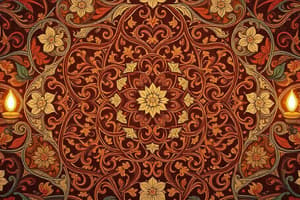Podcast
Questions and Answers
What is the Nth Term Test used for in sequences?
What is the Nth Term Test used for in sequences?
- To determine if a sequence converges by checking the limit of the sequence divided by n (correct)
- To determine if a sequence diverges by checking the limit of the sequence itself
- To determine if a sequence converges by checking the limit of the sequence itself
- To determine the order of elements in a sequence
What does a subsequence of a sequence involve?
What does a subsequence of a sequence involve?
- Selecting elements based on a decreasing sequence of natural numbers
- Selecting elements based on an increasing sequence of natural numbers (correct)
- Selecting only the prime-numbered elements
- Selecting all even-indexed elements of the original sequence
What happens to a divergent sequence?
What happens to a divergent sequence?
- It converges to a specific value
- It oscillates indefinitely between positive and negative values (correct)
- It converges to zero
- It remains constant at all terms
What do sequences play a fundamental role in within calculus?
What do sequences play a fundamental role in within calculus?
What applications do sequences have in physics, engineering, and signal processing?
What applications do sequences have in physics, engineering, and signal processing?
Flashcards are hidden until you start studying
Study Notes
Real Analysis: Exploring Sequences
In the vast landscape of mathematics, real analysis is a cornerstone that delves into the world of real numbers and their properties. One of the foundational elements of real analysis is the study of sequences, which can be thought of as ordered lists of real numbers. Let's embark on a journey to explore the intricacies of sequences, drawing from the fundamental principles that underpin real analysis.
Definition and Notation
A sequence of real numbers is a function (f:\mathbb{N} \rightarrow \mathbb{R}), where (\mathbb{N}) is the set of natural numbers. We often denote this sequence by (a_n), where (n) is a natural number, and (a_n) is the (n^\text{th}) term of the sequence.
Limits of Sequences
A fundamental concept in the study of sequences is the limit. A sequence ({a_n}) converges to a limit (L) if, for any (\varepsilon > 0), there exists an integer (N) such that for all (n \geq N), (|a_n - L| < \varepsilon). The limit of the sequence ({a_n}) is denoted as (\lim\limits_{n \to \infty} a_n = L).
Sequential and Topological Convergence
Sequential and topological convergence are two ways of thinking about convergence in analysis. Sequential convergence is the concept we've just introduced. Topological convergence is a more general concept that holds true in many topological spaces, not just the real numbers. The two notions are equivalent for sequences in the real numbers, but they diverge in other topological spaces.
Convergence Tests
There are various tests that can be applied to determine whether a sequence converges or not. One such test is the Nth Term Test, which states that if a sequence ({a_n}) converges to (L), then (\lim\limits_{n \to \infty} a_n = L) if and only if (\lim\limits_{n \to \infty} a_n^{(n)} = 0), where (a_n^{(n)}) is the (n^\text{th}) term of the sequence divided by (n). Another test is the Comparison Test, which states that if ({b_n}) converges to (L_b) and (|a_n| \leq |b_n|) for all (n), then ({a_n}) converges to (L_b).
Subsequences
A subsequence of a sequence ({a_n}) is a sequence that can be obtained by selecting a particular order of elements in the original sequence. The sequence ({a_{n_k}}), where ({n_k}) is an increasing sequence of natural numbers, is a subsequence of ({a_n}). A subsequence may converge to a different limit than the original sequence.
Divergent Sequences
Sequences may not converge, in which case they are said to be divergent. One example of a divergent sequence is ({n}), which does not converge to any limit. Another example is the harmonic sequence(\left{ \frac{1}{n} \right}), which diverges to (0). Divergent sequences can be classified as oscillatory or non-oscillatory. Oscillatory sequences are sequences that oscillate indefinitely between positive and negative values, while non-oscillatory sequences are sequences that do not have this property.
Applications
Real analysis, and the study of sequences in particular, has numerous applications in various fields of mathematics and sciences. Sequences are used extensively in the study of series, which are sums of terms of sequences. Sequences also play a fundamental role in calculus, where the limit concept is heavily employed in the definition of derivatives and integrals. Moreover, sequences are utilized in the study of Fourier series and power series, which are essential tools in physics, engineering, and signal processing.
Conclusion
Sequences are an essential tool in the realm of real analysis, offering a versatile approach to understanding the behavior of real numbers. Studying sequences provides a solid foundation for exploring more complex concepts in real analysis, such as series, limits, and the calculus of real numbers. So, embrace the exploration of sequences, for they are the gateway to a deeper understanding of the real world.
Studying That Suits You
Use AI to generate personalized quizzes and flashcards to suit your learning preferences.




